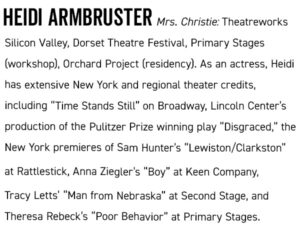Enjoy this exclusive interview between Script in Hand curator Mark Shanahan and Heidi Armbruster. Heidi is an actor and the playwright of our May Script in Hand Mrs. Christie.
FIVE QUESTIONS WITH HEIDI ARMBRUSTER
MARK: You have a great love for the Golden Age of Mystery, specifically the cozy novels by Agatha Christie. What made you first fall in love with the author?
HEIDI: My mom died! How’s that for an answer? I’ve always been a big reader, but I found that in the aftermath of my mother’s passing, I couldn’t concentrate on what I always thought of as “literature.” I had loved Christie as a kid, but as an adult, I dismissed her as a writer for Reader’s Digest book clubs and middle school students. But when I went back to her books in that movement of grief, I found she was exactly what I needed. Her books were accessible, plot-driven, you could pick them up and put them down, (or sometimes not put them down). The chapters were about the length of a subway ride. But the best part, was the contract that Christie makes with her reader; that by the end of the 250 pages, the world that she has broken down into chaos during the story, will be righted into miraculous and meticulous order. Agatha Christie was a really good friend to me in that hard moment in my life. Reliable, fun, cheeky, puzzling, surprising, nihilistic. And I read them all!
MARK: A lot has been speculated about the missing 11 days in Christie’s life. What did you learn about Agatha Christie when researching and writing this play ?
HEIDI: I learned a lot. I even took a pilgrimage to the Agatha Christie Festival in Torquay while researching this play. I learned that Christie fans are intense. There is a huge community of very devoted readers and many of them feel intense ownership over her work and her personal life. Another thing I learned – walking around the landscape of Torquay (the place where Christie grew up and then returned to live in later in her life) – is littered with places and geography that I recognized from her books; the seacoast, the rocky cliffs, houses hanging over the edge of the sea, rolling hills down to the river, winding country lanes, cobbled streets, dark, spooky corners. It felt like walking inside one of her novels. I found that I kept looking over my shoulder.
Another realization – it’s easy to think of Agatha Christie as an icon; that image of the stout older Queen of Crime – who looks much like Queen Elizabeth 2. But being in the landscape of Christie’s girlhood, reminded me that she was a young woman once, with heartbreak, grief, worries about money, fears of the future, just like all of us. Christie was 37 years old when her mother died and her marriage fell apart. I was 37 years old when I was salving my own grief and heartbreak with Christie’s novels. That parallel drew me into Christie’s private life. And my curiosity about “the-real-secret-life” of Agatha Christie provides the speculative jumping off point for my play.
MARK: You’re obviously very familiar with Christie’s characters and her style of writing. What was it like to create a voice for her as a character in your own play?
HEIDI: I had a great time writing Agatha. I particularly enjoyed the moments where her character does “bad” things. Or maybe I should say “recognizable” things? Human things. When we meet Agatha in the play, she is not in a good place. So, I felt a lot of permission for my Agatha to do things that another part of my brain would never think “the real Agatha Christie” would do; swear, worry about her dog, cry, go on a diet, try to look pretty, worry about her weight, panic, be sharp with people, get frustrated, not always be an awesome mom, want to kill people, want to disappear, you know, regular human stuff.
MARK: Your play takes place in two timelines, with a modern day character named Lucy as a Christie aficionado looking into the author’s past. Although separated by a century, how are Agatha and Lucy alike even as they are different? Do they share any similar traits?
HEIDI: There are a few actors in the play who play two characters, and I think of those pairs as being the same character separated by a hundred years. Similarly, Agatha and Lucy feel like two sides of the same coin – separated by a century. Both women are on the cusp of big life change. They are both contemplating the second act of their lives. They are both being asked to write that second act for themselves, by themselves, in a way that they never would have considered in their first part of their lives. That vibrating possibility is the string that connects them, which translates to being indefatigable, in spite of the temptation of despair.
MARK: Christie was not only a popular novelist, she was a wildly successful playwright, too. Did you study her plays as you crafted your own mystery for the stage?
HEIDI: From a technical standpoint, one of the things I love most about Christie’s novels is the way she writes dialogue. It makes sense to me that she also had a ton of success as a dramatist. The dialogue in the novels and plays is snappy, conversational, funny. It’s a high bar, but it was fun to try to mimic those rhythms in my play. And, she often uses exclamation points! And I love an exclamation point!
CLICK HERE or on the the graphics above to read Heid’s full bio.

